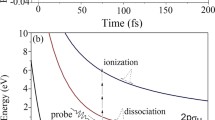Abstract
Owing to the degeneracy of the energy levels, the wavefunction of the electron in the excited states of the hydrogen atom and hydrogen-like ions perturbed by a neutral atom B is significantly different from the wavefunction of the unperturbed state. The perturbed function has a wide high maximum in the region of atom B, which is explained by multiple collisions of the electron with atom B, because the classical trajectories in the Coulomb field are closed and the size of atom B is much smaller than the size of the excited-state orbit. The radiative lifetimes of the excited states are much larger than those of unperturbed states. The orbital angular momentum L of the excited electron is strongly changed in collisions with atom B owing to the quantum interference or mixing of the temporal phases of adiabatic wavefunctions. The cross sections for such a change in the orbital angular momentum are several orders of magnitude larger than the cross sections found in early investigations in the approximation of the single collision of the electron with atom B.
Similar content being viewed by others
References
L. D. Landau and E. M. Lifshitz, Course of Theoretical Physics, Vol. 3: Quantum Mechanics: Non-Relativistic Theory (Nauka, Moscow, 1989; Butterworth-Heinemann, Oxford, 1991).
M. I. Chibisov, A. M. Ermolaev, M. Sherkani, and F. Brouillard, Zh. Éksp. Teor. Fiz. 117(2), 313 (2000) [JETP 90 (2), 276 (2000)]; M. I. Chibisov, Phys. Rev. Lett. 84, 451 (2000); J. Phys. B: At., Mol. Opt. Phys. 34, 49 (2001).
M. I. Chibisov, Zh. Éksp. Teor. Fiz. 120(2), 291 (2001) [JETP 93 (2), 256 (2001)]; Usp. Fiz. Nauk 172 (1), 3 (2002) [Phys.-Usp. 45 (1), 1 (2002)].
M. I. Chibisov, A. A. Khuskivadze, and I. I. Fabrikant, J. Phys. B: At., Mol. Opt. Phys. 35, L193 (2002).
A. A. Khuskivadze, M. I. Chibisov, and I. I. Fabrikant, Phys. Rev. A: At., Mol., Opt. Phys. 66, 042709 (2002).
M. I. Chibisov, Zh. Éksp. Teor. Fiz. 132(5), 1064 (2007) [JETP 105 (5), 927 (2007)].
I. V. Komarov, L. I. Ponomarev, and S. Yu. Slavyanov, Spheroidal and Coulomb Spheroidal Functions (Nauka, Moscow, 1976) [in Russian].
Yu. N. Demkov and V. N. Ostrovskii, Zero-Range Potentials and Their Applications in Atomic Physics (Leningrad State University, Leningrad, 1975; Plenum, New York, 1988).
T. M. Kereselidze and M. I. Chibisov, Zh. Éksp. Teor. Fiz. 68(1), 12 (1975) [Sov. Phys. JETP 41 (1), 6 (1975)]; M. I. Chibisov and T. M. Kereselidze, Preprint No. IAE-5410/6 (Institute of Atomic Energy, Moscow, 1991); T. M. Kereselidze, I. L. Noselidze, and M. I. Chibisov, J. Phys. B: At., Mol. Opt. Phys. 36, 853 (2003).
O. B. Firsov, Zh. Éksp. Teor. Fiz. 21, 1001 (1951).
V. S. Lebedev and I. L. Beigman, Physics of Highly Excited Atoms and Ions (Springer, Berlin, 1998).
V. S. Lebedev and I. I. Fabrikant, J. Phys. B: At., Mol. Opt. Phys. 30, 2649 (1997); J. Phys. B: At., Mol. Opt. Phys. 33, 1521 (2000).
A. Omont, J. Phys. (Paris) 38, 1343 (1977).
I. S. Gradshteyn and I. M. Ryzhik, Table of Integrals, Series, and Products (Fizmatlit, Moscow, 1962; Academic, New York, 1965).
L. D. Landau and E. M. Lifshitz, Course of Theoretical Physics, Vol. 1: Mechanics (Fizmatlit, Moscow, 1958; Pergamon, Oxford, 1960).
H. A. Bethe and E. E. Salpeter, Quantum Mechanics of One- and Two-Electron Atoms (Academic, New York, 1957; Fizmatlit, Moscow, 1960).
I. I. Sobelman, Introduction to the Theory of Atomic Spectra (Fizmatlit, Moscow, 1963; Pergamon, Oxford, 1972).
L. Hostler and R. H. Pratt, Phys. Rev. Lett. 10(11), 469 (1963).
L. Hostler, J. Math. Phys. (Melville, NY, USA) 5(5) 591 (1964).
W. Gordon, Ann. Phys. (Weinheim) 2, 1031 (1929).
L. D. Landau and E. M. Lifshitz, Course of Theoretical Physics, Vol. 4: V. B. Berestetskii, E. M. Lifshitz, and L. P. Pitaevskii Relativistic Quantum Theory (Nauka, Moscow, 1968; Pergamon, Oxford, 1971).
E. Fermi, Nuovo Cimento 11, 157 (1934).
I. I. Fabrikant and M. I. Chibisov, Phys. Rev. A: At., Mol., Opt. Phys. 61, 022 718 (2000).
E. E. Nikitin and S. Ya. Umanskii, Theory of Slow Atomic Collisions (Atomizdat, Moscow, 1979; Springer, Berlin, 1984).
R. W. Hamming, Numerical Methods for Scientists and Engineers (McGraw-Hill, New York 1962; Nauka, Moscow 1972).
S. K. Godunov and V. S. Ryaben’kii, Difference Schemes: An Introduction to the Underlying Theory (Nauka, Moscow, 1973; North-Holland, Amsterdam, 1987).
Methods in Computational Physics: Advances in Research and Applications, Vol. 10: Atomic and Molecular Scattering, Ed. by B. Alder, S. Fernbach, and M. Rotenberg (Wiley, New York, 1971; Mir, Moscow, 1974).
V. S. Marchenko and V. S. Lebedev, Zh. Éksp. Teor. Fiz. 84(5), 1623 (1983) [Sov. Phys. JETP 57 (5), 946 (1983)].
Author information
Authors and Affiliations
Corresponding author
Additional information
Original Russian Text © M.I. Chibisov, 2009, published in Zhurnal Éksperimental’noĭ i Teoreticheskoĭ Fiziki, 2009, Vol. 136, No. 6, pp. 1069–1093.
Rights and permissions
About this article
Cite this article
Chibisov, M.I. Perturbation of the excited states of the hydrogen atom and hydrogen-like ions by a neutral atom. J. Exp. Theor. Phys. 109, 924–945 (2009). https://doi.org/10.1134/S1063776109120036
Received:
Published:
Issue Date:
DOI: https://doi.org/10.1134/S1063776109120036



